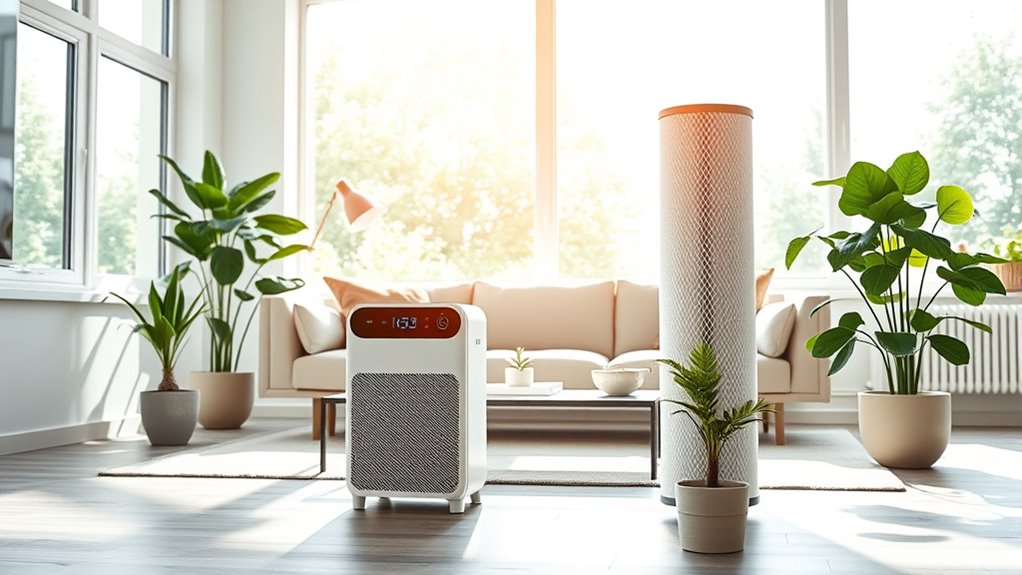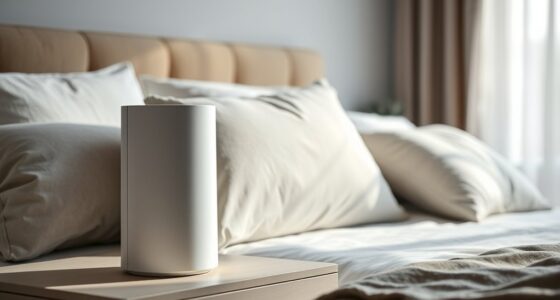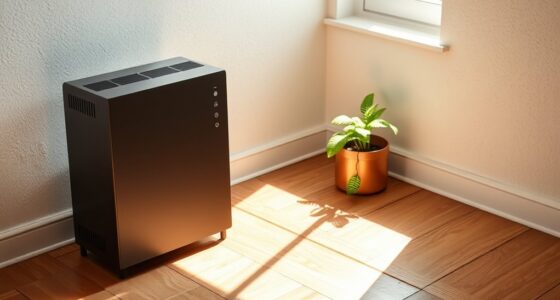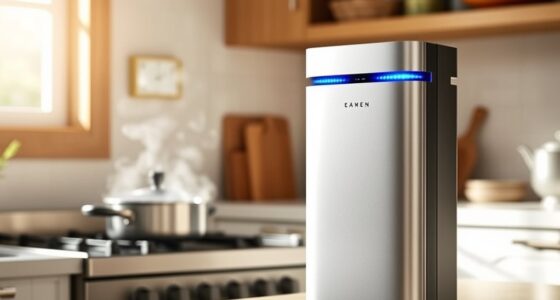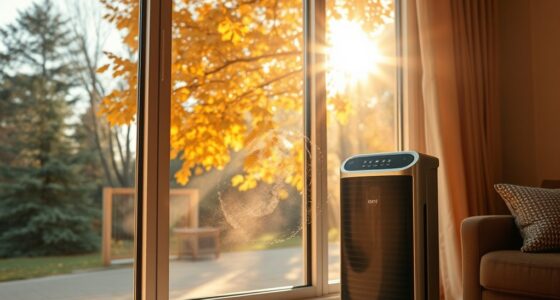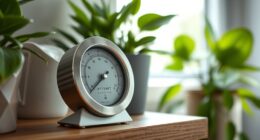To set up a whole-home air purification strategy, start by installing high-efficiency HEPA filters in your HVAC system to continuously trap pollutants like dust, pollen, and pet dander. Regularly replace filters every three months to maintain efficiency. Enhance air quality with additional purifiers in high-traffic rooms, and guarantee proper ventilation through exhaust fans or energy recovery ventilators. Combining these steps creates a healthier environment—keep exploring for more tips on optimizing your indoor air.
Key Takeaways
- Install high-efficiency HEPA filters in your HVAC system and replace them regularly for continuous allergen removal.
- Incorporate additional air purifiers with HEPA filters in high-traffic or allergy-prone rooms.
- Ensure proper ventilation using exhaust fans or energy recovery ventilators to dilute indoor pollutants.
- Regularly maintain and position filters and purifiers to maximize coverage and effectiveness throughout the home.
- Stay informed about latest air quality technologies to enhance your filtration and ventilation strategies.
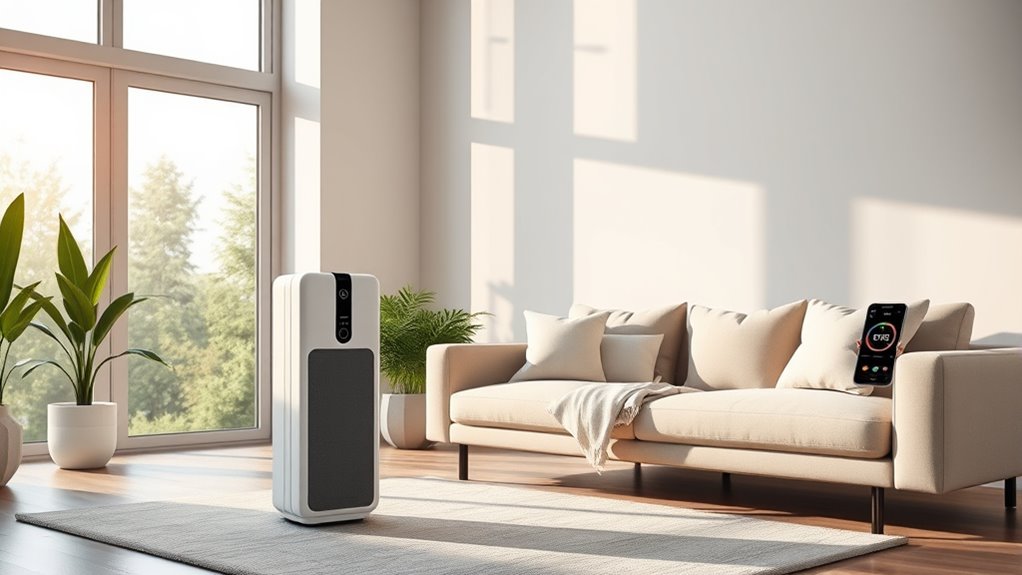
A whole-home air purification strategy is essential for creating a healthier living environment, especially as indoor air quality can substantially impact your health and comfort. When you prioritize effective air filtration, you’re actively reducing the presence of indoor allergens that can trigger allergies, asthma, or other respiratory issues. This process involves more than just installing a single filter; it requires a comprehensive approach that targets the entire house, ensuring that every room benefits from cleaner, healthier air.
Start by selecting the right air filtration system designed for whole-home coverage. High-efficiency particulate air (HEPA) filters are among the best options, capturing up to 99.97% of airborne particles, including dust, pet dander, pollen, and mold spores. These filters are particularly effective at removing indoor allergens, which often circulate through the air and settle on surfaces, only to become reintroduced into your breathing zone. When installed properly within your HVAC system, a quality air filter becomes a frontline defense, continuously working to purify the air as your system runs.
Use HEPA filters in your HVAC system for maximum indoor air allergen removal.
In addition to choosing the right filters, consider the placement and maintenance of your filtration system. Regularly changing filters—every three months or more frequently if you have pets or allergies—is crucial to maintain optimal performance. A clogged filter not only reduces airflow but also diminishes its ability to trap indoor allergens effectively. It’s also wise to invest in an air purifier with a HEPA filter for specific rooms where you spend a lot of time, such as bedrooms or living rooms, to give you an extra layer of protection against airborne irritants.
Ventilation plays a vital role in your whole-home air purification strategy. Properly ventilating your home helps to dilute indoor allergens and reduce indoor pollutant buildup. Use exhaust fans in bathrooms and kitchens, and consider installing an energy recovery ventilator (ERV) to introduce fresh air without losing conditioned air. These steps support the circulation of cleaner air and prevent the stagnation that allows indoor allergens to accumulate.
Additionally, understanding industry trends and incorporating the latest technology can further optimize your air quality. When you combine efficient air filtration with good ventilation and cleanliness, you create a comprehensive whole-home air purification strategy that remarkably improves your indoor air quality, making your living space healthier and more comfortable for everyone.
Frequently Asked Questions
How Often Should I Replace Air Purifier Filters?
You should replace your air purifier filters based on their filter lifespan, which varies by model and usage. Generally, replacement frequency ranges from every 3 to 6 months. Check your device’s manual for specific guidance. Regularly inspecting filters helps guarantee peak performance and cleaner air. Don’t wait too long, as clogged filters reduce efficiency and air quality. Staying on top of filter changes keeps your air purifier working effectively.
Can Air Purifiers Eliminate All Indoor Allergens?
Sure, your air purifier promises to eliminate all airborne allergens, but don’t hold your breath—literally. While it does a good job reducing allergens, it’s not magic. Purifier effectiveness varies, and some tiny particles slip through. Think of it as a good barrier, not an impenetrable wall. So, yes, it helps, but don’t expect it to banish every allergen; a thorough strategy works better.
What Size Air Purifier Do I Need for My Home?
To find the right air purifier size for your home, consider its capacity and room size compatibility. You’ll want an air purifier with a capacity suited for the square footage of each room. Measure your space accurately, then select a model that matches or exceeds that size. This ensures maximum filtration performance, helping to improve air quality effectively without wasting energy or money on an underpowered or oversized unit.
Are There Health Risks Associated With Air Purification Systems?
You might wonder if air purification systems pose health risks. While they generally improve indoor air quality, be aware of health implications like potential allergies to filter materials or ozone emissions from certain devices. Filtration limitations mean some pollutants, like gases or very small particles, may still escape. To stay safe, choose systems with proven safety features, and regularly maintain and replace filters to minimize risks and maximize benefits.
How Do I Maintain and Clean My Whole-Home Air Purifier?
Oh, don’t forget to treat your air purifier like royalty! Regularly check and replace filters to keep things running smoothly—skimp on filter maintenance, and you risk turning your system into a glorified paperweight. Clean the exterior and vents to prevent dust buildup. Doing this maintains your purifier effective, boosts system longevity, and ensures you breathe fresh air without the sneezing fit. After all, a little upkeep goes a long way!
Conclusion
By implementing a whole-home air purification strategy, you’re not just improving air quality—you’re creating a fortress that shields your family from invisible pollutants. With consistent maintenance and smart choices, you can breathe easier than you ever thought possible, turning your home into a sanctuary of pure, fresh air. Don’t settle for less—your health is worth a fortress of cleanliness that outshines even the freshest mountain breeze. Start today and transform your living space into the ultimate air oasis.
